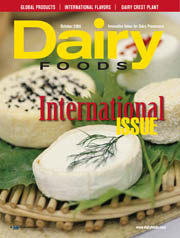
Milk is milk. Cheese is cheese. Yogurt is yogurt. These simple sentences have never been more untrue. Innovation is alive and thriving around the world and dairy foods appear to be one of the most dynamic categories. Read on.
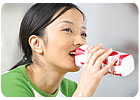
Fluid fantasia
The main trends in milk and fluid dairy beverages center around healthier and better-for-you options, with the top-positioning claims being vitamin and mineral fortified, low fat, low cholesterol, low sugar, added calcium and functional. Functional formulations include the addition of fiber, omega-3s and phytosterols.Overall, the greatest number of new milk and fluid dairy introductions are coming from Asia Pacific and Europe. Noteworthy drinks include Kaiku Plus Sin Lactosa from Spain's Kaiku Corp. This UHT lactose-free milk is enriched with vitamins A, D, E and folic acid and is said to be easy to digest. Central Lechera Asturiana, also in Spain, introduced Natur Calcio Plenitud, a fat-free milk with calcium, phosphorus and vitamins A, D and E, which is described as being formulated for menopausal women.
Hong Kong's Dairymas launched Anlene Active, a high-calcium, low-fat milk formulated with BoneMax, which the company says is a formula rich in vitamin D, magnesium and zinc and is said to help enhance and build bone mass.
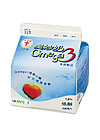
Omega-3s are becoming quite prevalent overseas as a functional ingredient in fluid dairy.
In Argentina, Mastellone launched Ser Skimmed Milk with Active Fibre, which is fortified with vitamins A and D and calcium. Its claim is to help improve the composition of the intestinal flora and help calcium absorption.
Other functional products include Sancor Bio from Argentina's SanCor. This partially skimmed milk contains probiotic bacteria and is said to be formulated to prevent osteoporosis, improve intestinal balance and encourage overall health. In Poland, Berglandmilch launched Fidus Aktiv, a 0% fat kefir milk drink said to actively support the immune system.
Italy's Parmalat introduced Parmalat Jeunesse, a skimmed milk with vitamin E, antioxidants and co-enzyme Q10. These ingredients are said to fight free radicals and help regenerate the body's well-being day after day.
In Denmark, Unilever Bestfoods introduced Becel Pro-Activ milk, which is said to help lower cholesterol. Mastellone in Argentina launched La Serenísima SereCol, a partially skimmed milk formulated with omega-3 fatty acids and plant sterols. The product claims to help reduce cholesterol and protect the cardiovascular system.
The United Kingdom's St Ivel introduced St Ivel Advance, a milk range enriched with omega-3s and targeted at families with young children. The company explains that omega-3s play a part in brain function by enhancing learning and concentration.
Although still few in number, milk and fluid dairy products claiming to have a low glycemic index (GI) have more than doubled in appearance in the past year. Most products overtly flag the fact that they have a low GI, while others simply state that they provide a sustained release of energy. At the moment this trend is more prominent in Asia Pacific and Down Under, but has the potential to move into Europe. For example, Australia's National Foods' Farmers Union Feel Good! markets a chocolate-flavored milk with no added sugar and a low GI. Pauls, also in Australia, introduced Slim Milk, a fat-free milk with no cholesterol and a low GI. In New Zealand, Fonterra introduced Primo, a lime-flavored milk with vitamins A and D that is described as sustained energy in a bottle.
It is also becoming more common to see value-added milks being lactose free. For example, Finland's Valio launched Valio Play, low-lactose coffee-flavored milks. The Play line includes fruit and milk smoothies, too. The line is targeted to on-the-go young adults looking for a good source of energy in a thirst-quenching beverage. Valio also markets Pro Feel Milk, a low-energy, fat- and lactose-free milk enriched with calcium, vitamin D and fiber.
Products claiming to be highly and easily digestible appeal to lactose-intolerant consumers. New products making such claims include Parmalat's Zymil Alta Digeribilità, a high-digestibility milk available in a one liter bottles. In China, Chenguang Milk introduced Lactobacillus Acid Milk, which is said to be easy to digest and to help replenish lost water and nutrition.
Age- and gender-targeted products continue to appear, catering for the specific nutritional needs of seniors, pregnant and nursing women, and children. For example, Mexico's Ganaderos Productores de Leche Pura introduced Alpura 40 Y Tantos, a milk for consumers 40 years and older, which is vitamin- and mineral-enriched and contains seven antioxidants.
In Russia, Lianosovski Milk Combenat introduced Agusha Ary-Mama, a sterilized, enriched milk with 2.5% fat that is suitable for pregnant women or nursing mothers. Spain's Central Lechera Asturiana launched Natur Calcio Mam
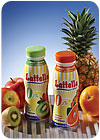
Fruit juice and whey drinks are very popular in Austria. Innovative line extensions focus on the addition of functional ingredients such as balm, ginseng and lecithin.
Beyond chocolate milk
While chocolate remains the most popular flavor in milk and dairy beverages, followed by vanilla and strawberry, an emerging trend is the use of more indulgent flavors such as marzipan, black forest cake, popcorn and others. For example, Salzburgerland Mozart Drink is from Austria's Alpenmilch Salzburg. This marzipan, nougat and chocolate flavored milk drink was inspired by Mozart Austrian pralines. In Russia, Lianozovskii Milk Plant launched Rizii Up, a milk drink for children with a bubble gum flavor.Blended real fruit juice and milk beverages are becoming increasingly popular. New introductions include Woolworths' Sour Apple in South Africa. In Austria, Berglandmilch introduced Fidus Aktiv Frisch & Vit, a whey drink with 10% blood orange juice enriched with vitamins and minerals. And in Germany, Plus Vertriebs launched Alpa Milk & Juice drink, a skimmed milk drink with 25% juice from mandarin, passionfruit and guava.
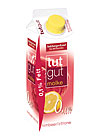
Fruit juice and whey drinks are very popular in Austria. Innovative line extensions focus on the addition of functional ingredients such as balm, ginseng and lecithin.
Making whey drinkable
In Austria's Alpenmilch Salzburg markets Tut Gut Molke, which translates to "do good." It's a mix of fruit juice and whey, a combination that has really taken off in Austria. Recently the company expanded the Tut Gut line with a variety designed for baby boomers. This formulation contains lecithin, which has been shown to help improve memory and concentration. The company also markets JoBu, which is a blended buttermilk and yogurt drink that comes in five flavors: cherry, multi-fruit, orange, mango and strawberry.Tirol Milch, also of Austria, has a very popular line of whey drinks marketed under the Latella brand. Most recently the company rolled out Latella Plus, which is fruit, whey and additional functional ingredients such as ginseng for energy or balm for relaxation.
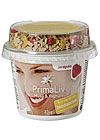
Emmi offers a yogurt with aloe vera for inner beauty and pomegranate for overall health. There's also a trend in providing consumers the opportunity to mix dried fruits, nuts and grains into their cup of yogurt.
Drinkable yogurt and fermented milk
Europe remains the clear leader with regard to cultured dairy products, particularly yogurt and fermented milk drinks. After Europe, it's Asia Pacific.When it comes to cultured dairy, the excitement continues to be with probiotics, as well as symbiotics, which include both pre- and probiotic ingredients to promote better digestive and immune support. There's also a heightened focus on heart health with cholesterol and blood pressure lowering claims.
For example, in Spain, Ganaderia Priégola introduced under the Simbi brand, a new range of yogurt drinks with prebiotics, probiotics and omega-3 fatty acids. In New Zealand, New Zealand Dairy Foods introduced under the Metchnikoff Symbio brand, a low-fat symbiotic yogurt with acidophilus, casei and oligosaccharides. This combination, according to the company, assists with inner health.
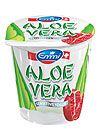
Emmi offers a yogurt with aloe vera for inner beauty and pomegranate for overall health. There's also a trend in providing consumers the opportunity to mix dried fruits, nuts and grains into their cup of yogurt.
For example, Italy's Latteria Sociale Merano introduced under the Bionessere Henri Chenot brand, Action Anti-Oxydant, a reduced-lactose, fructose-sweetened, probiotic dairy drink that also contains polyphenols from grapeseeds to give it antioxidant attributes. This is said to help prevent cellular aging.
Japan's Meiji Dairies launched Beautiful Tomorrow, a fermented milk drink and a yogurt developed in collaboration with a dermatologist. The products are formulated with LB81 lactic acid bacteria, collagen and ceramide, all which are said to be good for the skin. Calpis Ajinomoto Danone, also in Japan, introduced a beauty yogurt containing berry juices, rosehip, collagen and vitamin C.
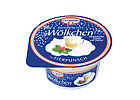
Quark is a fresh, unripened cheese that is often sold and consumed in a fashion similar to yogurt.
More inner health: the heart
There are numerous heart-healthy products that claim to regulate blood pressure through the addition of bioactive peptides. For example, Japan's Calpis introduced Ameal S 120, a probiotic yogurt drink containing lacto-tripeptide, which is an ingredient claimed to help lower blood pressure. Calpis licenses the use of its bioactive dairy peptides to Unilever Bestfoods, which markets Pro-Activ with Lacto-Peptides beverage in Portugal and the United Kingdom.In Spain, Kaiku Corporacion introduced Kaiku Vita, a functional dairy drink formulated with Evolus active complex from Valio, which is claimed to lower elevated blood pressure levels. Switzerland retailer Migros introduced Mivolus, a strawberry-flavored yogurt drink with bioactive peptides and minerals to reduce blood pressure. In Italy, Danone introduced under its Danacol brand, a daily-dose bottle of fermented dairy beverage containing vegetable sterols that claim to help reduce cholesterol.
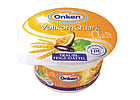
Quark is a fresh, unripened cheese that is often sold and consumed in a fashion similar to yogurt.
When cultured becomes cheese
Europe is home to a variety of unique dairy foods seldom found in the States. For example, quark is a white, unaged cheese that has a consistency somewhere between cream cheese and ricotta. It is often sold, and typically served sweetened with a variety of ingredients including fruit and whole grains. For example, Germany's Dr. August Oetker Nahrungsmittel KG markets an eggnog quark-style dessert for the Christmas holidays. There's also an apple with pear variety, as well as a quark containing whole grains and flavored with grapes, dates and figs.Fromage frais is also a fresh white cheese, unavailable in all but the most special of specialty shops in the United States. It is a creamy soft cheese made with whole or skimmed milk and cream. In Europe, it is available plain or flavored with fruit or with herbs and spices. It has the consistency of a cream cheese but with fewer calories and less cholesterol.
In France, Nestlé introduced under its Yoco brand, P'tit Yoco Oméga 3, fruit-flavored fromage frais rich in omega-3s, which are said to help brain development, and claimed to be formulated for the needs of children during their growth period.
Fromage frais is often used as a filling in chocolate candies. So, instead of a nougat or a caramel center, there's fresh cheese. For example, Austria's Landfrisch Molkerei recently introduced Landfrisch Rudi, a fine chocolate roll with fromage frais. It is described as being for people who want to enjoy a sweet treat without feeling guilty.
Belgium's AKC Belgium, a manufacturer of low-fat cream cheese and Belgian chocolate, decided to combine the two and add some functional ingredients. New Arnouts Light is a chocolate cream cheese spread rich in omega-3s and contains dietary fiber. The company says the spread helps strengthen the intestinal flora.
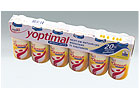
Australia's National Foods Ltd., markets Yoplait yoptimal, a probiotic yogurt drink that is specially formulated with a synergistic combination of probiotics, prebiotics and natural antioxidants in the form of green tea. This formula is said to help repair, restore and replenish the body's inner balance.
Other functionalities
Most probiotic drinks claim to strengthen the body's immune system and regulate the digestive system. It is unusual, therefore, to see a probiotic drink talk about benefits to the liver. However, recently there have been two such product launches in South Korea.Maeil Dairy introduced Gut HD-1, a yogurt claimed to be beneficial for the liver, and formulated with hovenia dulcis extracts and enriched with calcium and vitamin B6, C and E. Seoul Milk introduced Hefas probiotic yogurt drinks formulated with hovenia dulcis extract, tomato extract and enriched with eight vitamins.
Danone has introduced a number of products that focus on aiding the removal of fat from the body or are beneficial to muscles. For example, in Guatemala, new under the Danone Vitalinea brand is a natural-flavored yogurt drink formulated with Livian-V, an active ingredient said to aid in the elimination of fat. In France under the Taillefine brand Ligne, there's a range of healthy dairy drinks available in two varieties: Capital Musculaire, which contains kiwi and soya, is rich in protein and is said to be beneficial to muscles; and Regulation des Graisses, which contains pineapple and green tea and is rich in calcium to help the body regulate fat metabolism.
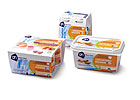
Phytosterols, which are associated with lowering cholesterol, are finding dairy to be an ideal carrier. Applications include Cheddar cheese, cup and drinkable yogurt, and milk drinks.
Something for everyone
There has been activity in the area of relaxing yogurts for children. For example, in Spain, Danone introduced under the Danonino brand, Felices Sueños (translates to happy dreams), which is a vitamin- and calcium-rich children's drinking yogurt that contains herbs associated with facilitating a good night's sleep. For added fun, once empty, the bottle glows in the dark. In Brazil, Nestlé introduced under the Chamyto brand a fermented cultured dairy beverage for children that comes in a Day and Night 6-count pack. The three Strawberry and Guarana varieties are to be consumed in the morning, while the three Passion Fruit and Chamomile varieties are for night.In Russia, Agusha Agu-Mama introduced a range of fruit yogurt drinks targeted at pregnant or nursing women. They are enriched with vitamins, taurine and polyunsaturated fatty acids such as omega 3 and 6, which are beneficial for cell formation and brain activity.
Austria's Nöm introduced Vital+, a yogurt range targeted at seniors, which is enriched with "Vitalstoff-Komplex," a special formulation said to help balance bad nutritional habits and strengthen intestinal flora.
In Portugal, Danone added a rooibos tea variety to its Bio Activia Ch
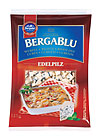
"Full of health and on the move," is how the company describes Käsebrot, a new kind of snack bar that is made up of a slice of dark wholemeal bread topped with a slice of cheese. Bleu cheese is also more convenient when it comes sold in cubes.
Top it off with cheese
When it comes to cheese, "low" positionings continue to thrive, that is, low in fat, low in calories and most recently, low in trans fat. For example, in Brazil, Itambé introduced a creamy cheese spread with 35% less calories than regular cream cheese, and in Switzerland, retailer Coop released Lifestyle Swisstaler, a low-calorie Emmental cheese. In Brazil, Unilever Bestfoods released Doriana Cream Cheese in an olive-flavored variety, which flags that it is free from trans fats.Another prominent trend in Europe is to make cheese from yogurt. This complements the low-in-fat trend, as yogurt helps lower the fat content of cheese products, while it also improves texture. For example, Spain's Arias Dairy released under the San Mill

"Full of health and on the move," is how the company describes Käsebrot, a new kind of snack bar that is made up of a slice of dark wholemeal bread topped with a slice of cheese. Bleu cheese is also more convenient when it comes sold in cubes.
Herbs and peppers remain the most popular flavors with cheese; however, many unique flavors are making their way into this category. For example, Austria's Landfrisch has introduced Rollino Italienische Kräuter, which is hand-rolled fresh cheese with Italian herbs. In Germany, EBM released Tenery Grillkäse Kräuter, an herb-flavored barbecue cheese that can be grilled or pan fried.
Portugal's Käsehandels Gesellschaft Rosenheim launched under the Etoile d'Or brand, Fromage a Pate Molle Cremeuse Peperoni, a soft cheese with white mold and peppers. Plus Vertriebs in Austria released under the Hofmaier Delikatess Scheiben brand, Paprika-Peperoni, which is smoked cheese slices with peppers and chillies.
In Japan, Snow Brand Milk Products broached the cheese sector with two regionally inspired cheeses intended to be consumed with beer. The range includes Wasabi & Soy Sauce and Sweet & Spicy Miso. Finnish Cheese Company of Espoo, Finland, markets Silva-brand processed cheese in flavors such as bear, moose, wild boar and even reindeer.
On that note, the innovations in dairy foods know no limits. It's a great time to be a manufacturer and marketer of dairy foods any where on this great planet.
Sidebar: Global Food Regulatory Issues Impacting Dairy Foods
Biotechnology and nanotechnology highlight the growing divide between the European Union (EU) and the United States in food manufacturing. Safety considerations have been altogether removed from discussions concerning regulation of biotechnology and other emerging technologies. For some reason, the EU and other major markets are skeptical of the use of anything other than conventional methods of food production. And, interestingly, many developing countries are moving to establish a European model for their domestic policies, leading to greater trade difficulties as the United States continues to invest in these advanced technologies to improve quality and manufacturing efficiencies.The online industry periodicalFood Navigatorpublished an interview with Ruth Rosselson, of the U.K.-based Ethical Consumer Research Association, in which she cited the increasing importance to consumers of how companies source their products, i.e., their impact on the environment and how they treat their workers. Rosselson referenced genetically modified foods, the humane treatment of animals and the fair trade movement as the most visible products of the expanded discussion of ethical issues in the marketplace for food.
Advanced technologies in food processing are creating a trans-Atlantic divide. Many regulatory developments have signaled major reforms in food manufacturing and marketing. These changes will not only influence product development and consumer choices, but also trade and possibly litigation.
Separately, the European Commission (EC) has adopted a set of measures designed to overhaul the EU rules on food improvement agents. Under the new proposed rules, harmonized EC rules would be laid down for the evaluation, approval and control of food additives, flavorings and enzymes used in food.
For example, the proposed legislation regulates enzymes for the first time at the EU level. Currently, only enzymes used as food additives are covered by the law on food additives and only two enzymes (lysozyme and invertase) are authorized under this legislation. Controls on the remaining enzymes, which are added to food to perform a technological function in the manufacture, processing, treatment or storage of such food, including enzymes used as processing aids, are not harmonized across the EU and are subject to different measures in each Member State. The EC proposal will harmonize the regulation of enzymes throughout the European Union and establish EC procedures for the safety evaluation and authorization of food enzymes.
The key aspect of the legislation is the introduction of a single common procedure for the approval of food additives, flavorings and enzymes. This approval procedure includes a safety evaluation by the European Food Safety Authority. The articulated benefits of this common approach include simplified legislation and more consistency in the procedures used to approve additives, flavorings and enzymes.
The regulations are still in the approval process, and it is likely to take at least 18 months before becoming EU law. Once the new rules are adopted, they will apply to all EU Member States. This major and long-awaited change in EU food and food ingredient regulation will impact U.S. companies that export to EU Member States.
This insight provided courtesy of Foley & Lardner LLP, Washington, D.C. Authors Mark Mansour, partner in the Washington D.C. office, and Sophie Lignier, of counsel in the Brussels office, are members of the firm's Food Industry Team. He can be reached at mmansour@foley.com and she can be reached at slignier@foley.com.